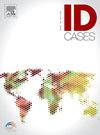Nasopharyngeal swab for the diagnosis of SARS-CoV-2 (COVID-19) infection complicated by severe pneumococcal meningitis
IF 1
Q4 INFECTIOUS DISEASES
引用次数: 0
Abstract
The nasopharyngeal swab is the reference test for diagnosing coronavirus disease 2019 (COVID-19) and other respiratory pathogens. Although this procedure appears to be risk free and was performed thousands of times daily during peaks of the COVID-19 pandemic, as well as during influenza and bronchiolitis outbreaks, it can be associated with minor to serious risks. These range from simple epistaxis to breaches of the meninges and skull stalks. Some breaches occur in the presence of anomalies such as congenital, traumatic or surgical encephaloceles. Neuro-meningeal breaches can be complicated by bacterial infections. We report the case of a 57-year-old woman diagnosed with Streptococcus pneumoniae meningitis following a nasopharyngeal swab for reverse transcription polymerase chain reaction testing. She had been experiencing cerebrospinal fluid leakage for 1 year after a nasopharyngeal swab performed on an unidentified encephalocele. Antibiotic treatment followed by surgical repair of the encephalocele led to full recovery. Although nasopharyngeal swab tests seem simple, clear instructions are essential for both sample collectors and patients, and any complication, even minor, must be carefully considered. Bacterial meningitis is a serious disease that can cause death or irreversible neurological sequelae. The presence of clear fluid flow after a nasopharyngeal swab should prompt investigation for a meningeal breach. Detecting such a breach may reveal a pre-existing or newly formed malformation, allowing for specialized care to prevent severe complications such as meningitis.
鼻咽拭子诊断SARS-CoV-2 (COVID-19)感染合并严重肺炎球菌脑膜炎
鼻咽拭子是诊断2019冠状病毒病(COVID-19)和其他呼吸道病原体的参考检测。尽管该手术似乎无风险,并且在2019冠状病毒病大流行高峰期以及流感和细支气管炎暴发期间每天进行数千次,但它可能与轻微至严重的风险相关。其范围从简单的鼻出血到脑膜和颅骨柄的破裂。有些裂口发生在先天性、外伤性或手术性脑膨出等异常情况下。神经-脑膜破裂可因细菌感染而复杂化。我们报告的情况下,57岁的妇女诊断为肺炎链球菌脑膜炎后鼻咽拭子逆转录聚合酶链反应测试。她在对不明脑膨出进行鼻咽拭子检查后出现脑脊液漏1年。抗生素治疗后手术修复脑膨出导致完全恢复。虽然鼻咽拭子测试似乎很简单,但对于样本收集者和患者来说,明确的说明是必不可少的,任何并发症,即使是轻微的,都必须仔细考虑。细菌性脑膜炎是一种严重的疾病,可导致死亡或不可逆转的神经系统后遗症。鼻咽拭子检查后出现清晰的液体流,应提示检查是否有脑膜破裂。检测到这样的裂口可能会发现先前存在的或新形成的畸形,从而允许进行专门护理,以防止严重的并发症,如脑膜炎。
本文章由计算机程序翻译,如有差异,请以英文原文为准。
求助全文
约1分钟内获得全文
求助全文

 求助内容:
求助内容: 应助结果提醒方式:
应助结果提醒方式:


